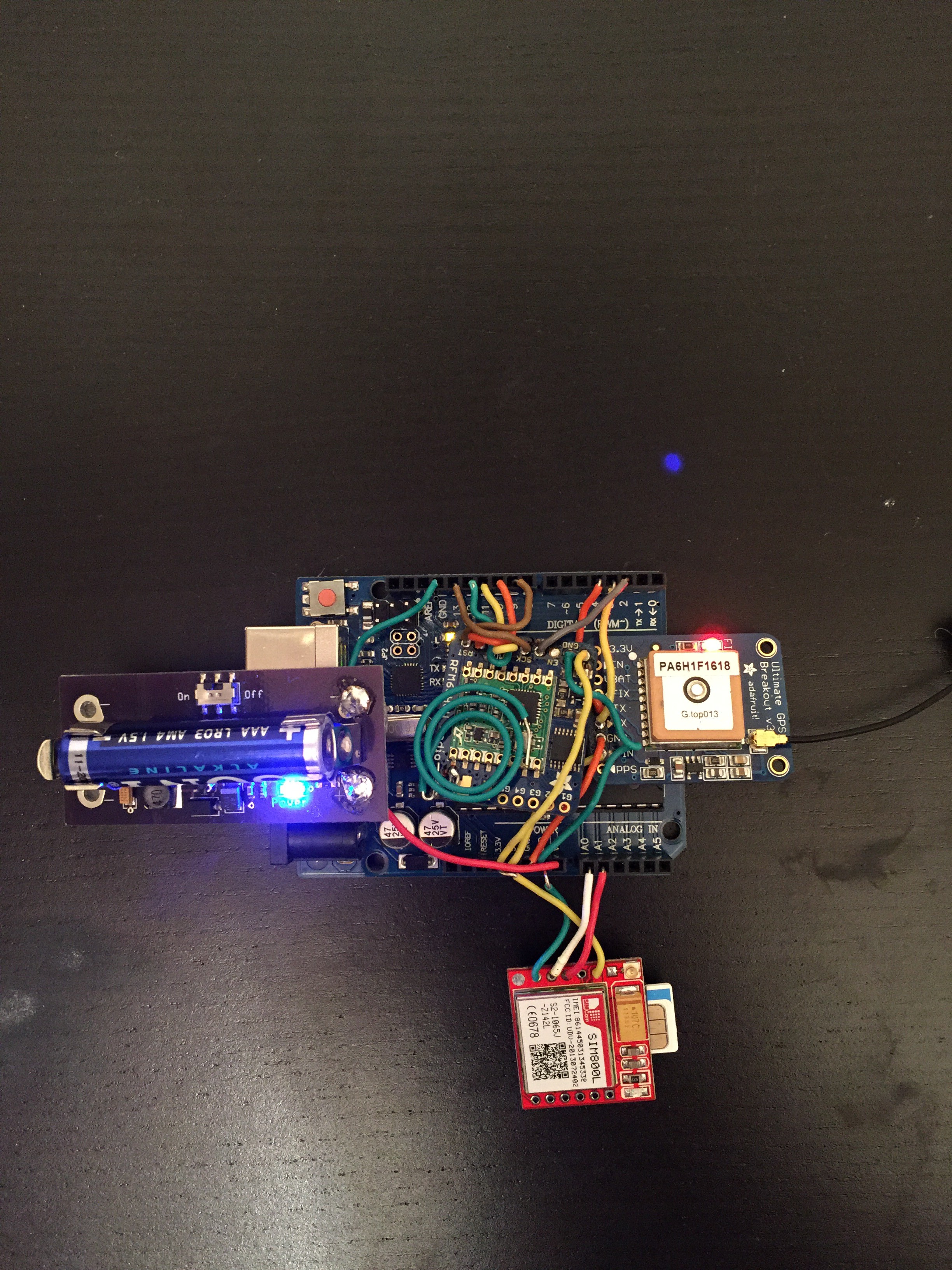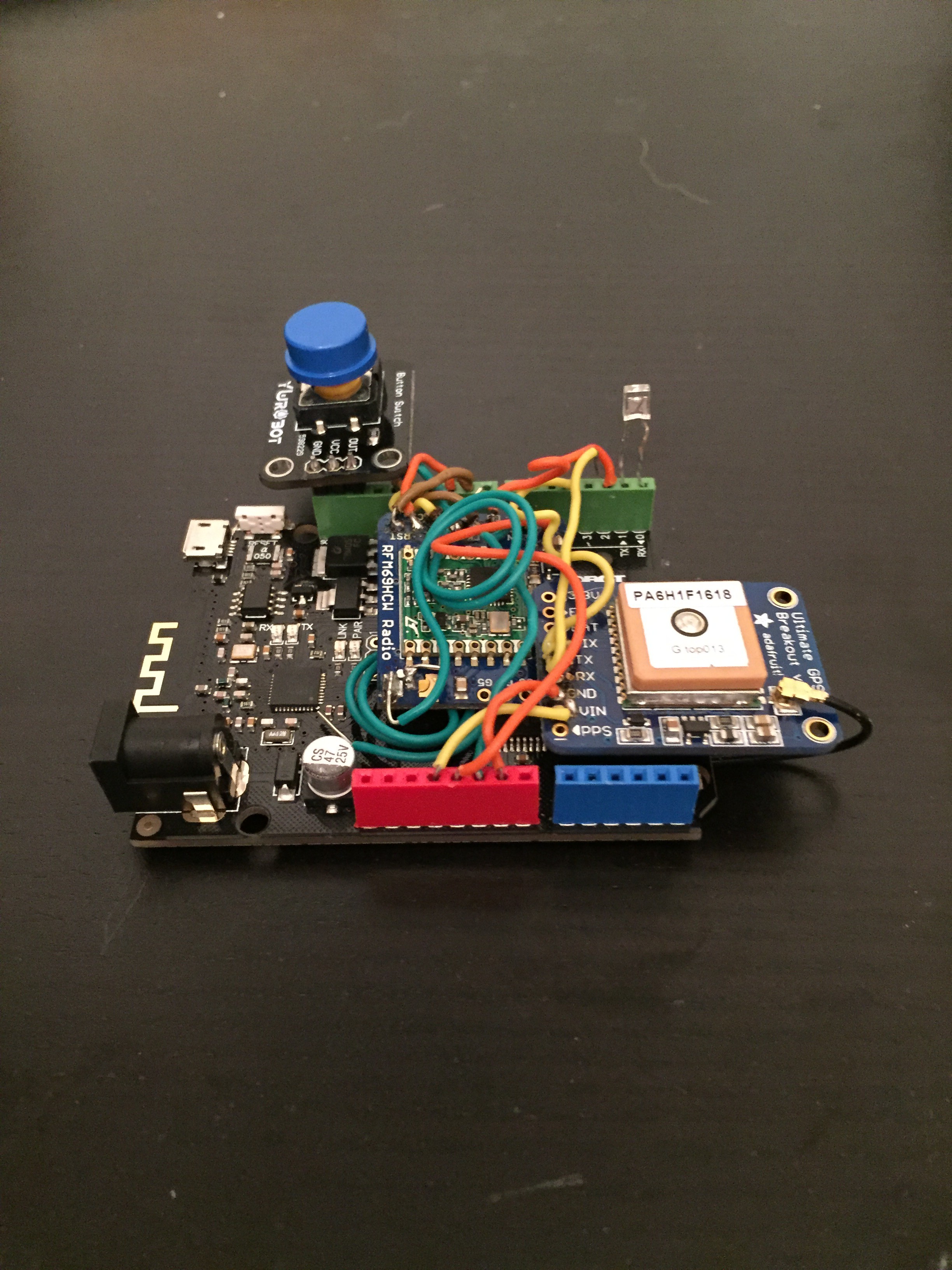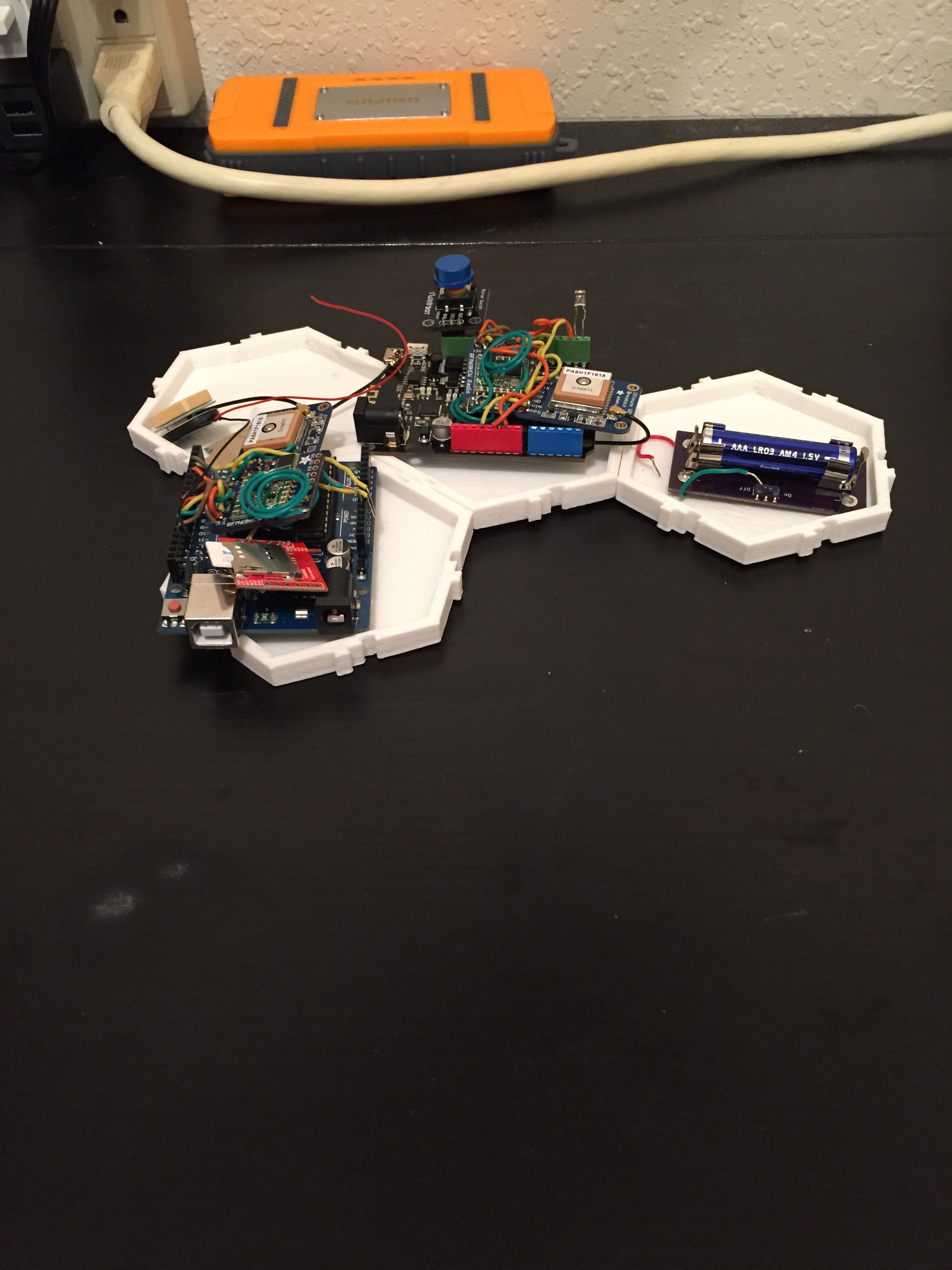KID SOS
A DEVICE DEDICATED TO ASSIST PARENTS IN KEEPING THEIR CHILDREN SAFE.
As parents, we live in a society today that can be extremely scary. We want our children to feel secure and safe. The KID SOS system can be used as another safety tool for parents. Composed of two devices, a parent and child unit, the KID SOS will alert the parent of their wandering child, in addition to tracking the location of their child. The KID SOS is designed to be discrete and stay attached to even the most active children.
Project Overview:
ALERT SYSTEM FIRST, TRACKER SECOND
KID SOS alerts then tracks. It works by measuring the distance between the two units. For this project the distance was set to 30 feet. When the two units are greater than 30 feet away from each other, the parent unit sends an alert, Alert 1, to a connected smartphone, and a text message which reads, “Heads up, child unit has wandered, starting 30 second countdown…(Countdown from 30 seconds appears here in text message)”.
This will be followed by an alarm noise emitted by the parent unit. If after 30 seconds the Parent and Child units are still greater than 30 feet from each other, a second text message is sent to the smartphone. The second alert, Alert 2, message reads, “Countdown complete. Most recent location of child is (GPS Latitude and Longitude, and distance apart in feet displayed here in text message)”.
At this point the buzzer on the Parent unit will turn off, and Alert 2 updates will continue to be sent out every 30 seconds. To save the cost of a cell phone bill, this information is being sent between the units through the RF modules, and then from the Parent unit to the smartphone over bluetooth.
If there is no GPS fix, the RF modules are used to determine the distance between the two units (see equations below). If the RF modules are unable to connect, the child unit has a built in GSM module with an activated sim card. I chose Ting because there is no monthly charge, and pay as you go seemed like the best way to go for this project.
If the RF modules cannot connect, the GSM will start sending out Alert 2, to the smartphone it was connected with. Once the two units are brought back within 30 feet, of each other, a third alert, Alert 3, will be sent to the connected smartphone which reads,”Child located, both units have been reset.”
Components List:
Parent Unit:
- Bluno Arduino Module - A bluetooth integrated Arduino. Specs can be found at the following link: https://www.dfrobot.com/wiki/index.php/Bluno_SKU:DFR0267
- Adafruit Ultimate GPS Module - Specs can be found at the following link: https://learn.adafruit.com/adafruit-ultimate-gps/overview
- RFM69HCW - 433Mhz radio module breakout board. Specs can be found at the following link: https://learn.sparkfun.com/tutorials/rfm69hcw-hookup-guide
- 1 W Speaker - Mini 20x14mm Audio Woofer 8 Ohm 1W.
- 1 AAA Battery Power Converter- LilyPad Power Supply Module AAA Battery Step up to 5V Converter for Arduino
Child Unit:
- Arduino Uno R3 - Specs can be found at the following link:
- Adafruit Ultimate GPS Module - Specs can be found at the following link: https://learn.adafruit.com/adafruit-ultimate-gps/overview
- RFM69HCW - 433Mhz radio module breakout board. Specs can be found at the following link: https://learn.sparkfun.com/tutorials/rfm69hcw-hookup-guide
- sim800L Breakout Module - Specs can be found at the following link: https://cdn-shop.adafruit.com/datasheets/sim800h_hardware_design_v1.00.pdf
- Sim card by Ting - can be found here: https://ting.com/shop/gsmSIM
- 1 AAA Battery Power Converter- LilyPad Power Supply Module AAA Battery Step up to 5V Converter for Arduino
Additional Details:
KID SOS Cost Breakdown:
PART NAME | QTY | COST EACH | COST x QTY |
GPS MODULE | 2 | 36.91 | 73.82 |
BLUNO MODULE | 1 | 34.95 | 34.90 |
BATTERY CONVERTER | 2 | 1.72 | 3.44 |
BUZZER | 1 | 3.84 | 3.84 |
SIM CARD | 1 | 8.50 | 8.50 |
GSM MODULE | 1 | 4.34 | 4.34 |
AAA BATTERY | 2 | 1.00 | 1.99 |
ARDUINO UNO R3 (GENERIC) | 1 | 3.78 | 3.78 |
RFM69HCW MODULE | 2 | 13.95 | 27.90 |
95.03 |
KID SOS Images/Screenshots:



KID SOS Testing:
- Parent Unit - Succeeded in testing all applicable functions of modules on Parent unit through serial monitor output. Successfully received GPS coordinates from child unit over RF. Successfully processed information and used distance calculation formula. Tested LED in place of buzzer, successful test of range based on GPS data, exchanged over RF. Results were inconsistent due to poor signal. Was tested indoors with limited passive antennas. The formula I used could use some altering.
- Child Unit - Succeeded in testing all applicable functions of modules on Child unit through serial monitor output. Successfully sent GPS coordinates from child unit over RF to parent unit. Successfully received GPS coordinates from parent unit over RF.
Project Balance:
Previous to this project, I had minimal experience with programming in C++. During this experience, I was able to learn about programming the modules used. I have a full time job. I married an incredible woman, and we have two beautiful toddlers (even when they are cranky).
This project is very important to me as it will be a tool I can use to ensure my own children’s safety. I worked on this project during any spare time I had, including lunch at work, my toddler’s nap time on the weekends, and occasional weeknights. However, the project did not trump important parental duties such as reading books or playing dinosaurs. Both of those activities require my full attention. If you didn’t know, dinosaurs is a multi-faceted game with important rules that change without warning. When reading books to my daughter, if I turn that page too early, too late, or when it was her turn, she uses her vocal cords to let me know.
My point is, to me, it is imperative to find a balance in life between projects, work, family, and life. The chance for a cool project will come around again, but the chance to see my kids creativity first hand, will not always be there.
KID SOS Future Development:
I plan on developing the project further. My goals over the next year are listed below:
- Smaller Size - With SoC designed chips, and dedicated modules, the KID SOS can be manufactured small enough to fit under a large bandaid. This application would allow quickly applying it for trips to the store or park, and easy removal.
- Waterproofing - Kids and technology don’t always have a happy relationship. I have made a few test covers out of silicone that I think could be adapted to work as a cover for the KID SOS, which could be worn at water activities.
- Rechargeable - Using primary cell batteries is great, they are disposable and typically have a greater capacity compared to secondary cells. That said, rechargeable batteries are also extremely convenient, so I plan on making this adaptable to a lithium ion thin film battery, the flexible kind.
- MEASURING DISTANCE WITH RF
If the GPS can’t get a signal, RF can be used to get a rough idea of distance. The theory is that if you known the frequency of the RF module, you have a known constant. If you use a dipole straight wire antenna, and you know the length of the antenna, then you know the wavelength, and this provides another constant. With two known constants, and knowing the speed of light, at which RF travels, a distance can estimate, even when things like walls and other types of media are in the way.
- POWER ASSIST BY SWEAT BATTERY
It sounds gross, but it is, or is it? Here is how it works...A simple battery is made up of an anode, cathode, electrolyte, and separator. The skin sweat battery is composed of the following materials, graphite paper = anode, aluminum tape = cathode, sweat = electrolyte, adhesive from aluminum tape = separator. Since sweat flows, you have a constant source of fresh electrolyte. That means this is a primary cell, that will last until the electrolyte runs out, that is, if you stop sweating. In my case that is never.
KID SOS Arduino Sketches:
Parent and Child Unit Sketches: Can be found at this link:
https://github.com/FeAlias/KID-SOS
Project Logs (Scroll down a little further to read them):
I really enjoyed keeping a project log for this competition. I found it helped me stay focused on my project, and gave me a way to relieve stress when assessing what progress I had made (or hadn’t).
I also found it useful to help me develop a pattern for future projects at home. Project logs, steps, to do lists, anything that helps you think in an organized way is beneficial in all phases of life.
About Me:
I am FeMan, no really I have a high level of iron in my blood. Also, HeMan was taken so one letter away is FeMan, and no copyright problems.
I have a Masters Degree in Material Science, and I have been learning to program in Arduino since… not very long. In 10 weeks I am very proud of what I was able to learn from this project.
I have kids. I love my kids. I worry about my kids. I know they can’t be bubble wrapped, or even expect them to keep a roll of duct tape on them at all times for emergencies. However, it is a different world now than when I grew up. When I was 14 or so, I remember riding my bike to a friends house about 10 minutes away. I wouldn’t let my kids do that now. I remember going on sleepovers at friends houses around that age too. I wouldn’t trust anyone with my kids now, except close family.
Nothing is 100%. What I can do, is adapt to an increasingly dangerous world, by creating tools that parents can use to help them do a job that seems to getting increasingly more chaotic with every generation.
Special Thanks To:
I had a lot of help from family and friends, and the Arduino community. I think some of the people that helped out would prefer not to be mentioned by name, so I respectfully keep your privacy, and hope you see this message and know how much I appreciate all your help. THANKS!!!